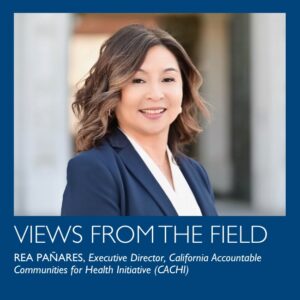Rea Pañares, Executive Director, California Accountable Communities for Health Initiative (CACHI)
In 2018, the Camp Fire—the most destructive and deadly fire in California’s history—claimed 85 lives and destroyed over 18,000 structures in rural Butte County. In the town of Paradise, homes, schools, hospitals, clinics, and community-based organizations were gone in a matter of days. With little time to recover, the county endured further crises—the North Complex Fire, COVID-19, and the Dixie Fire—leaving health and public systems decimated. Local leaders were addressing urgent crises and were overwhelmed, while a provider shortage and barriers to health care access were simultaneously impacting community health.
Understanding that the community needed not just programs but infrastructure to recover, the California Accountable Communities for Health Initiative (CACHI) funded the launch of Butte County’s Accountable Community for Health (ACH). An ACH brings together cross-sector leaders and community residents—facilitated by a trusted backbone organization—to address complex health and equity challenges that demand long-term coordination and shared leadership. In Butte County, the collaborative came together quickly to identify priorities and, within a year, had launched more than 10 community-led health initiatives, as well as a local Wellness Fund, laying the foundation for long-term systems change. Building on CACHI’s initial investment, the ACH secured support from local co-sponsors and a state grant to move health equity efforts forward.
In Butte County—and in the other 35 ACHs across California—CACHI has seen how support for collaborative infrastructure allows communities to lead with lived experience, set priorities tailored to local needs, and develop solutions that are both responsive and sustainable.
How Collaborative Infrastructure Anchors Resilience
CACHI works to advance health and equity by building community-rooted, cross-sector collaboratives that share power and drive lasting change. Through the Accountable Communities for Health model, we invest in local leadership and infrastructure to shift systems, influence policy, and address the root causes of health inequities—so all communities can thrive.
This approach creates the conditions to address long-standing inequities and urgent crises alike. For funders, the collaborative model offers a direct line to community priorities as they evolve in real time.
While Butte County demonstrates how an ACH can respond in the wake of disaster, many ACHs focus on ongoing challenges—from health care workforce shortages and chronic conditions to housing insecurity and public safety. Here are a few examples:
- In Imperial County—a rural, agricultural community designated as a Health Professional Shortage Area and hit hard by COVID-19— Imperial County ACH is identifying workforce needs to alleviate provider burnout and inform workforce development strategies for the county.
- In the San Francisco Bay Area, Marin 9 to 25 is combining grant funding, government support, and community partnerships to drive youth-led wellness initiatives targeting issues ranging from mental health to financial literacy.
- In South Los Angeles, Community Response System of South Los Angeles (CRSSLA) is collaborating with Managed Care Providers on equitable health care delivery and conducting community-driven data collection to guide local policy recommendations.
When funders—whether philanthropic, public, or community-based—support collaborative infrastructure, communities are better able to align local priorities, strengthen trust across sectors, and build responsive and sustainable systems of care.
Building Collaboration and Shared Leadership Takes Time
This kind of infrastructure does not emerge fully formed. Even with strong leadership, launching and sustaining an ACH requires time, intentional power-sharing, and sustained investment. Therefore, CACHI focuses on the relational work of systems change—strengthening governance, shifting mindsets around equity and shared leadership, and building capacity for sustainability. We also recognize that all of this must move at the pace of local relationships, available resources, and the unique challenges each community faces.
Central to this model is the integration of the community’s voice as a core strategy, not as an occasional input. Some ACHs prioritize resident participation and leadership from the outset; others evolve into this structure over time. But in every case, health equity can only advance when solutions are supported, informed, and led by those most impacted. This requires learning from residents about how to strengthen trust between community members and health and social systems, compensating residents for their expertise, creating pathways to leadership, and supporting safe spaces for engagement.
We’ve distilled our approach into the following strategies for funders who want to deepen their impact:
- Invest in infrastructure, not just programs—support what connects the work, not only what delivers services.
- Allow communities to lead—fund long-term community influence and decision-making, not just short-term consultation.
- Encourage funder alignment—collaborate with other funders to strengthen and sustain local efforts.
- Work at the pace of the community—honor the time it takes to build the trust and alignment necessary to support effective and equitable collaboration.
The New Reality for Health Philanthropy
The need for collaboration has never been more urgent. Whether responding to systemic inequities, wildfires, public health emergencies, or imminent threats to immigrant and LGBTQ+ communities, we need to be able to act quickly and work with trust and solidarity. As the health and social sectors face federal funding losses, and as political support for equity and community health infrastructure weakens, the responsibility—and opportunity—to build an equitable future is falling increasingly to states, local communities, and grantmakers. It is critical to underscore, however, that these sectors cannot fully compensate for the loss of federal investment. In this new reality, investing in equity-driven infrastructure and trusting communities to lead is essential—not just to withstand the storm, but to strengthen communities for what lies ahead.
References
Blue Shield of California Foundation. “Imperial County ACH: Case Study.” July 2019.
California Accountable Communities for Health Initiative (CACHI). “Community Response System of South Los Angeles (CRSSLA).”
Smith, Adam B. “2024: An Active Year of U.S. Billion-Dollar Weather and Climate Disasters.” Climate.gov. January 10, 2025.

